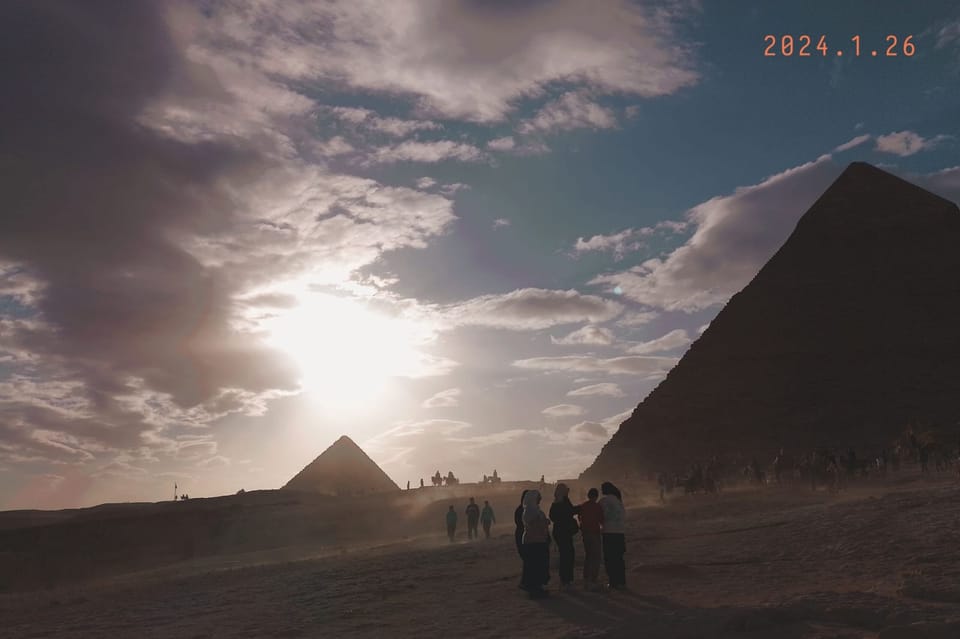Egypt Episode 1 - A Journey through Time and Sand

Hello Friends 👋,
You may have heard of the Pyramid Principle if you work in consulting. The famous Barbara Minto's logic-driven method to present your thinking clearly to clients. Well, guess what? I went to see the actual pyramids! As I sit here in a vibrant Cairo café, savoring the local Egyptian Mint Tea, I can't help but share my adventures and findings with you from my long-anticipated trip to Egypt.
1. The Alluring Start to an Egyptian Adventure
Now, three days into the journey, I find myself giddy with excitement, and it's not just from the copious amounts of caffeine in my tea. It's from my visit to the Pyramids of Giza, a testament to the grandeur of the ancient Egyptian civilization. These structures, erected by the three generations of the ancient Egyptian Pharaoh Khufu, stand majestically in Giza against the backdrop of the golden desert and the Gobi. The sight is awe-inspiring, and even the faint scent of camel dung in the air adds an authentic touch to the experience.
2. Unraveling the Pyramid Mysteries
As an eternal student of history, I find myself pondering over the intricacies of these pyramids. Known as a funerary complex, each pyramid was meticulously built by the reigning king for himself. The pyramids, with their square base and four monumental triangular faces, are a sight to behold. Interestingly, the Egyptian term for this type of building comes from a root meaning "climbing." But don't worry, no climbing was done on my part - I strictly adhered to the rules!
3. The Philosophy Behind Pyramids
The ancient Egyptians' fascination with the cycle of life and death is embodied in the construction of the pyramids. Over a hundred pyramids dot the landscape of Egypt, all built on the Nile's west bank, where the sun sets, symbolizing death. This choice of location was not random but deeply rooted in their beliefs around death and rebirth.
The Egyptians perceived death not as an end, but as a part of a continuous cycle. They drew parallels with the sun's daily journey and the annual Nile floods, associating it with life's progression: birth, growth, death, and rebirth. This belief found expression in the grandeur of the pyramids, standing as silent witnesses to this profound belief system.
In early ancient Egyptian civilization, the concept of the soul's rebirth and immortality was a privilege reserved for the king. The pharaohs' pyramids were not just structures preserving their physical remains, but also the foundation for their return to life after death. They were designed to provide sustenance for the soul of the Pharaoh, believed to roam freely after death. Thus, the pyramids' importance extended beyond the physical to the spiritual realm, making them central to Egyptian beliefs.
4.Pyramids are actually global
Surprise! While the Egyptian pyramids are famously known worldwide, pyramids are not exclusive to Egypt. Quite the contrary, the tetrahedral shape of pyramids was a global trend in many ancient civilizations.
The Mayan, Aztec, Greeks, Romans, and Sudanese - they all built their own grand versions of these structures. As the physical stability of a pyramid structure can be credited to its wide base and the distribution of weight. The pyramid's broad base enhanced its stability. Furthermore, the structure evenly distributes weight from the top down, contributing to its overall durability and resilience.
However, the Egyptian pyramids hold the crown due to their monumental scale and enduring presence through millennia, uniquely reflecting the engineering ingenuity of their creators.
5. The Real Builders of the Pyramids
The common perception is that the pyramids were built by slaves. However, this notion couldn't be further from the truth. The real architects behind these grand structures were not slaves but farmers during their off-seasons. They were hired by the state and rewarded for their labor. It's a testament to their skill and dedication.
6. The Decline of the Pyramid Era
By the end of the Sixth Dynasty, around 2181 BC, the construction of pyramids in Egypt had largely ceased. This change naturally prompts the question: Why did they stop building these architectural marvels? The cessation was not due to a decline in religious beliefs but rather a shift in their expression.
Temples, symbols of divine power and a means to reinforce national religious beliefs became the preferred structures. The high cost of building pyramids, considering their size, was another deterrent. Furthermore, due to their imposing size, pyramids became obvious targets for tomb robbers, which led Pharaohs to prefer more inconspicuous resting places to remain undisturbed.
As my tea slowly cools and the aroma of spices fills the air, I'll sign off for now. My Egyptian adventure has only just begun, and I can't wait to share more of my experiences with you. So, until next time, remember, that not all those who wander are lost. Some are just busy trying to find a pyramid!
Yours in wanderlust,
Sherman


Member discussion